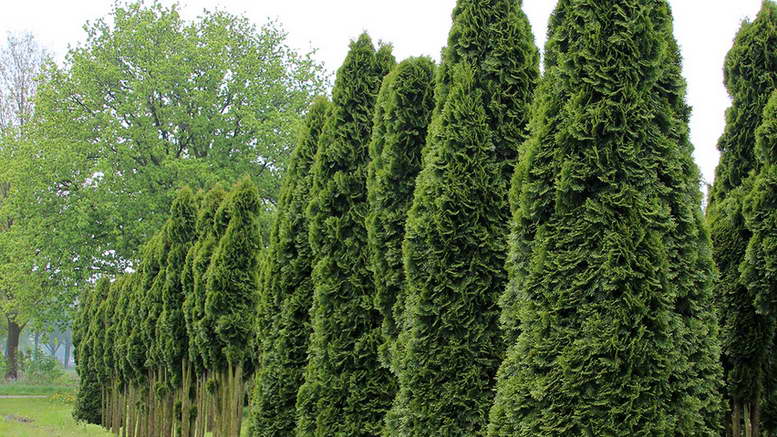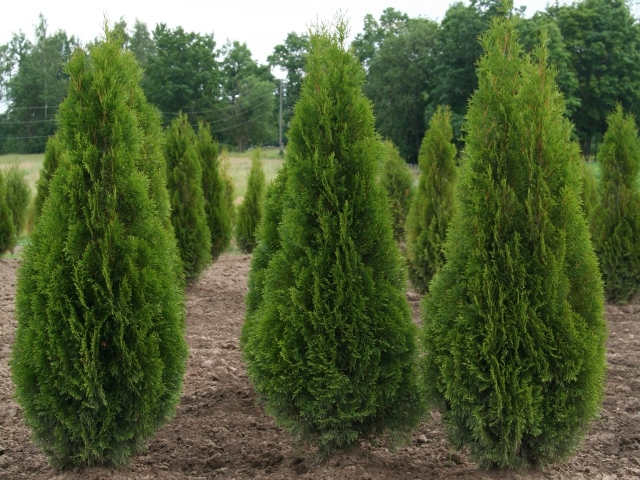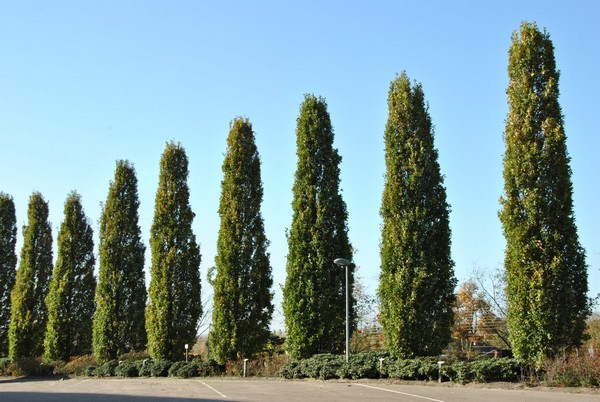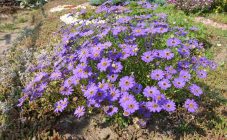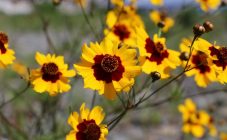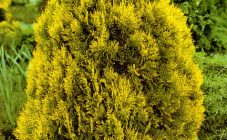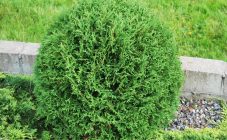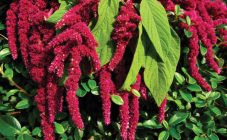Content:
Tui are evergreen coniferous shrubs and even trees up to 70 m tall, the trunk diameter of which can reach from 2.5 to 6 m. The leaves of young plants are rather soft, needle-shaped. These are monoecious plants with oblong or oval cones, which have from 2 to 6 pairs of scales, and the upper ones are sterile. Thuja Fastigiata has recently been in great demand among gardeners.
Description tui Fastigiata
Thuja western (variety bred in Germany) Fastigiata has a dense crown, columnar or conical shape. The characteristics say that this is a tree. The crown diameter does not exceed 3 m. Life expectancy is up to 200 years. The growth of most specimens stops after reaching the mark of 15 m, unlike other shrubs and trees of the Cypress family, the height of which can reach 70 m (in gardens it does not exceed 11 m), and the diameter is up to 6 m.
Thuja Fastigiata prefers open, sunny locations. It is there that the crown of this plant looks the most colorful and decorative. However, in the spring, in order to avoid burns, it is better to shade young plants. For stable growth and development, thuja needs a fertile, moderately moist soil, loams with a good structure are especially suitable. If the area is swampy, a drainage system is needed. Regular mulching of the soil is also required: in summer with mowed grass, and in winter with spruce branches, which will protect the trunk from damage by rodents, mainly voles. On dry soil and in the shade, thuja can lose the decorative effect of the crown.
In good conditions, thuja Fastigiata grows 30 cm up and 5 cm in breadth in a year. Almost immediately, the crown becomes dense and dense. In adult plants, the needles are scaly. In the first year, small brown bumps appear, no more than 1.5 cm in size.
Landing
Thuja columnar does not need particularly careful care, moreover, it tolerates air pollution in large cities quite persistently. Therefore, it is often used for landscaping streets and squares. You can buy thuja in many nurseries, but some amateur gardeners like growing seedlings on their own. They are received in two ways:
- from seeds;
- by cuttings.
If strict requirements are not imposed on the future thuja, then you can try to grow a seedling from purchased seed material or from harvested cones. They are collected for this purpose from September to December. Later they will open and the seeds will fall out. Preparatory work is carried out as follows:
- The cones are cut and laid out to dry in a cool room with a constant temperature not exceeding 7 ° C.
- Then the seeds are taken out and stored in the same bag of gauze until the first snow.
- Seeds in bags are laid out on a designated plot of land and a layer of snow of at least 30 cm is poured on top. The process of natural stratification has started.
In the spring, frozen seeds are removed from the bags and sown in prepared beds every 10 cm.The embedding depth is no more than 0.5 cm. Then it is sprinkled with earth or sawdust from coniferous trees. Watered little by little, but regularly, not allowing anyone to dry out. Seed germination with this method of planting is not less than 90% of the total. The soil must be mulched with peat or sawdust. Seedlings are very delicate, they need to be protected from sunlight. For the first 3 years, their growth will not exceed 40 cm. Then the seedlings dive. Grown and matured plants for 4 or 5 years can be planted in a permanent place.
The vegetative method of propagation of thuja Fastigiata is based on the correct choice of substrate, preparation of cuttings and subsequent care. It is best to carry out cuttings of conifers in the spring, as this allows cuttings to take root in the same year. Cuttings harvested in summer can only form callus. The root system will begin to develop in them only next year. It is necessary to harvest planting material in the morning or evening hours, as well as in cloudy weather. There are several rules to follow to get viable cuttings with great potential:
- The best donor tree is 4 to 8 years old.
- Cuttings about 12 cm long are cut from the upper lateral shoots with a pruner or a sharp garden knife.
- They are trimmed, placed in water or a weak solution of potassium permanganate (potassium permanganate) for 18-24 hours.
- Landing is carried out at an angle of about 30 ° to a depth of 5-6 cm.
- It is necessary to maintain a distance of 10 cm between the cuttings, leave 15 cm between the rows.
It is not necessary to harvest cuttings from the lateral shoots of thuja, as trees with twisted trunks will grow from them, which form an unsuccessful crown. This entails a loss of decorative appearance and threatens to worsen the surrounding landscape. Therefore, in the selected thuja, the upper part of the crown is cut in advance, and the remaining branches are pulled out in horizontal directions. Because of this, the tree will sharply throw out many vertical shoots, which are optimally suited for cutting cuttings from them. For the best aesthetic appearance in the future, planting and caring for a columnar thuja seedling is a very important point.
The nuances of caring for western thuja seedlings
Subsequent care consists in timely watering with strict control, which does not allow drying out or waterlogging. In addition, the seedlings should be exposed to sunlight for about 6 hours a day. This serves as a guarantee for the formation of a dense and correct crown in the future.
Thue Fastigiata does not require additional feeding. The tree is viable enough on suitable soil with proper lighting. But in order for its foliage to acquire a dark and rich green color, it is better to apply a nitrogen-containing fertilizer. Long-term fertilizers are applied in the spring.
The western thuja needs to be prepared for the winter period. Protect the gorgeous crown from the piercing cold wind and severe frosts. To protect dense branches from heavy snow, the crown must be tied, and the lower branches must be pulled and tied to the trunk, and then covered with spruce branches, burlap, and special kraft paper. Do not pour a thick layer of snow on the seedlings, as this will cause heating during the periodic spring thaws. Dwarf trees do not cover, they are under a loose layer of snow and winter safely.
In the summer, after the shoots have begun to grow and all the buds have developed, you can start trimming the crown. The next stage of its formation will begin only in the last decade of August. In order for the crown of the tree to look especially impressive, you need take care of them regularly, preventing them from growing in different directions. Cutting thin branches does not require much physical effort, so this pruning does not take much time. Work is done with a clean tool. Cuts will heal faster if the cutting edge is sharp enough. The shape of the blade also plays a significant role, so a special garden knife is the best option. In rainy weather, during fog, it is not worthwhile to engage in crown formation, since there is a threat of diseases of the damaged areas.
Thuja western disease
Sometimes on the thuja you can find shoots of brown or yellow color and dried sections of branches. So this tree is damaged by fungus. The disease begins gradually. Almost imperceptible brownish scales appear, and then the entire shoot begins to change color and die. As a preventive measure, foundationol (0.2%) is used, with which the entire plant is treated 2 times a month throughout the summer period, as well as September and October.
If the thuja western Fastigiata has turned yellow from the sun's rays, its branches can be treated with zircon, epin or other growth stimulants.
If drying out of young runs and falling of needles are found, treatment with copper-containing preparations is started. When thuja aphids or false shields appear on the trees, they are treated with karbofos, rogor, and also antio.
Sometimes the needles can turn yellow from sudden cold weather. This is such a peculiar reaction, after a while the green color will be restored again.
Using thujaFastigiatain the landscape
Western thuja trees, which have a compact pyramidal crown, are especially relevant in urban landscaping. Tuyu can be found in parks and squares. Its high decorative properties, as well as resistance to the action of vehicle exhaust gases, put these trees in one of the first places among all green spaces.
In open areas of country houses and mansions, the western thuja is planted in the form of a green fence, which prevents the penetration of street dust, cold winds, and simply closes the territory from prying eyes. Also, individual trees are decorated with themed flower beds, small ponds with fountains.
Thuja Fastigiat has many advantages. It is easy to clean and looks great in any landscape design style. If done correctly, as described above, she will live 200 years!
